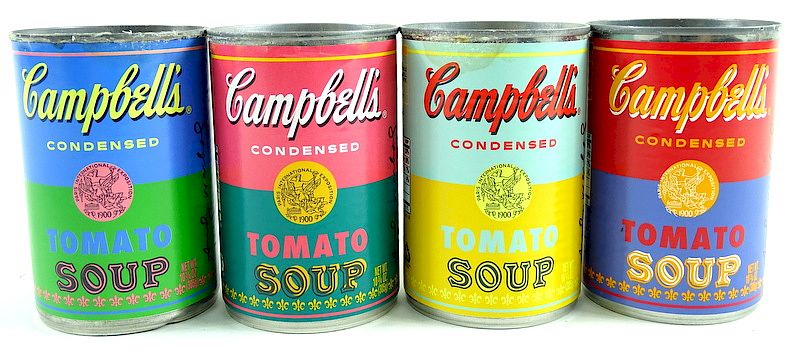January is NATIONAL SOUP MONTH. (Though of course anytime is just fine for soup.) See below for soup stories, soup poems, mathematical soups, scientific soups, and artistic soups (well, soup cans); find out how to volunteer at a soup kitchen; and learn about life’s (possible) origin in primordial soup. And much much more…
Table of Contents
SOUP STARTERS
| Soupsong, a large and multifaceted website wholly devoted to soup, covers soup myths, folktales, and poems; soup in the movies and in art; soup history; soup in the news; soup etiquette; and many international and historical recipes for soups. There’s even a list of Deathbed Soups, and – under Soup Songs – the complete lyrics to “Who Threw the Overalls in Mrs. Murphy’s Chowder?” | |
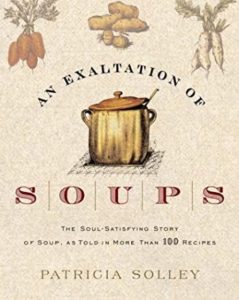
|
Patricia Solley’s An Exaltation of Soups (Clarkson Potter, 2004) is a fascinating compendium of all things soup, packed with history, folklore, quotations, and a host of international recipes. For teenagers and adults. |
SOUP STORIES
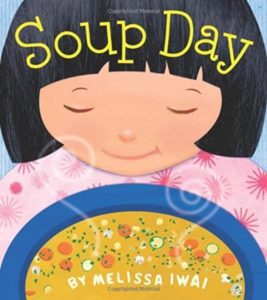
|
In Melissa Iwai’s Soup Day (Henry Holt and Co., 2010) – illustrated with bright collages – a snowy day is declared “soup day,” and a little girl and her mother go to the market for vegetables, prepare a pot of soup, spend a cozy afternoon reading and playing, and then share a soup supper when Daddy comes home. Included is a recipe for Snowy Day Vegetable Soup. A homey read for ages 3-6. |
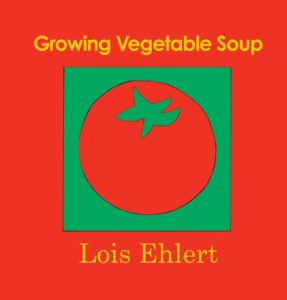
|
In Lois Ehlert’s brilliantly illustrated Growing Vegetable Soup (Sandpiper, 1991), a child and parent plant, water, weed, and harvest a garden full of gorgeous vegetables, and finally make a pot of vegetable soup. A recipe for soup is included. For ages 4-8. |
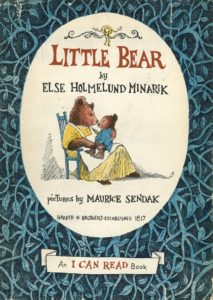
|
In the story “Birthday Soup” in Else Holmelund Minarik’s Little Bear (Harper Trophy, 1978), Little Bear is convinced that his absent mother has forgotten his birthday. Since he has carrots, potatoes, peas, and tomatoes, he decides to make Birthday Soup for his friends – but just as he, Hen, Duck, and Cat gather around the table, Mother Bear arrives with a beautiful cake. For ages 3-7. |
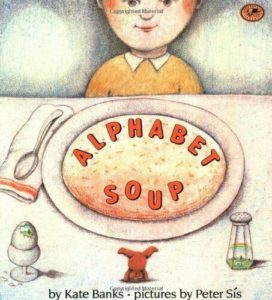
|
In Kate Banks’s Alphabet Soup (Dragonfly Books, 1994), a little boy does not want to each his lunchtime bowl of alphabet soup. (“My, you’re grumpy as a bear,” said his mother.) The boy then scoops the letters B-E-A-R out of his soup – and a bear appears. Off the two go, armed with a large spoon, on a fantasy adventure, involving an ogre, a wizard, and a sailboat, all called into being by the letters in alphabet soup. For ages 4-8. |
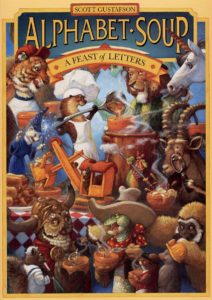
|
In Scott Gustafson’s lushly illustrated Alphabet Soup (Greenwich Workshop Press, 1994), Otter invites 26 alphabetical animal friends to a housewarming party, each to bring an ingredient for soup. All do, from Armadillo (asparagus) to Zebra (zucchini). A lot of wonderful language – Unicorn, for example, brings useful utensils, transported via unicycle in an upside-down umbrella. For ages 4-8. |
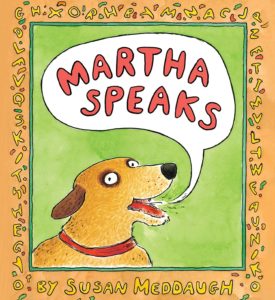
|
In Susan Meddaugh’s Martha Speaks (Houghton Mifflin Harcourt, 1992), Martha, the family dog, eats a bowl of alphabet soup – and suddenly she can talk. The problem: sometimes Martha talks too much. Many funny sequels, for ages 4-8. |
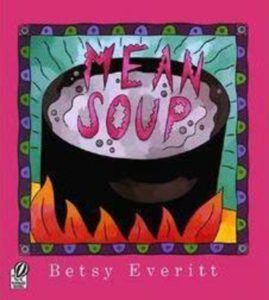
|
In Betsy Everitt’s Mean Soup (Sandpiper, 1995), Horace has had a horrible day. (Zelda sent him a love note. The show-and-tell cow stepped on his foot.) He arrives home in a mean mood, so his creative and sympathetic mother suggests they collaborate on a cathartic pot of Mean Soup. After yelling at the soup, making faces at the soup, and even (well, yes, unsafely) banging on the soup pot, Horace’s mean mood has been stirred away. For ages 3-8. |
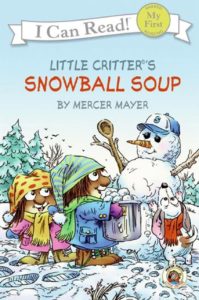
|
Mercer Mayer’s Snowball Soup (HarperCollins, 2007), an I Can Read Book, features the Little Critter characters making lunch for their snowman. Suggested activity to accompany this one: invent your own soup recipes to feed hungry snowmen. For ages 4-7. |
| Snowman Soup has a recipe, instructions, and printable labels for making a great do-it-yourself gift of “Snowman Soup” – actually hot chocolate with marshmallows. | |
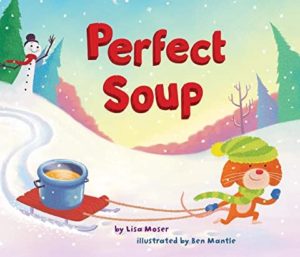
|
In Lisa Moser’s Perfect Soup (Random House Books for Young Readers, 2010), Murray, a perfectionist mouse, needs a carrot for his pot of Perfect Soup. Getting one, however, proves difficult, and devolves into a long chain of favors, as Murray dashes from Farmer (who wants logs hauled), to Horse (who wants jingle bells), to Shopkeeper and on. Finally, Snowman offers help while asking nothing in return – and grateful Murray donates his hard-won carrot to make Snowman a nose. For ages 3-7. |
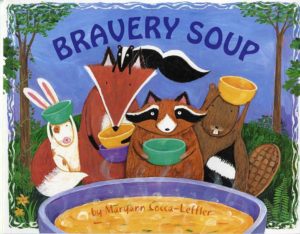
|
In Maryann Cocca-Leffler’s Bravery Soup (Albert Whitman & Company, 2002), cowardly (but adorable) Carlin the raccoon is sent on a dangerous quest by Big Bear to fetch the last ingredient for a pot of Bravery Soup. Off Carlin goes through the Forbidden Forest to fetch a box from a scary cave on Skulk Mountain. When he finally makes it home, it turns out that the box is empty. The message: Bravery isn’t found in Bravery Soup, but inside oneself. For ages 3-7. |
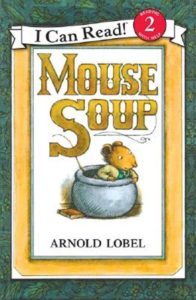
|
In Arnold Lobel’s Mouse Soup (HarperCollins, 1983), a mouse has been nabbed by a hungry weasel, who plans to turn him into Mouse Soup – but the quick-thinking mouse, by means of four clever stories, convinces the weasel that he needs many additional ingredients for soup (among them bees, crickets, and a thorn bush). The gullible weasel heads off on a disastrous collecting expedition, while the mouse heads happily home to have supper and finish reading his book. For ages 4-8. |
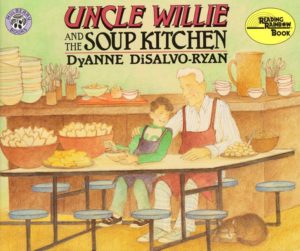
|
In DyAnne Disalvo-Ryan’s Uncle Willie and the Soup Kitchen (HarperCollins, 1997), a young boy helps at the soup kitchen where his Uncle Willie volunteers daily – because, Willie explains, sometimes “people need help.” A Reading Rainbow selection. For ages 4-8. |
| From the Smithsonian’s Food & Think blog, Count Rumford and the History of the Soup Kitchen is the story of the first real soup kitchen, established in the mid-18th century to feed the beggars of Munich. | |
| For background information and guidelines for becoming a soup kitchen volunteer, see How to Volunteer at a Soup Kitchen from the How Stuff Works website. | |
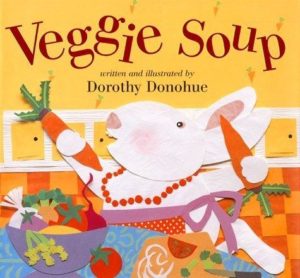
|
In Dorothy Donohue’s Veggie Soup (Winslow Press, 2000), Miss Bun – a pink-cheeked bunny in an apron – sets about making a wholly original soup. Animal friends arrive to share their favorite soup ingredients – Bird brings worms; Toad, bugs; Cow, hay – and soon the collaborative soup is horrible. Miss Bun starts over, turns out a yummy vegetable soup, and starts a neighborhood soup kitchen. Included is a vegetable soup recipe. For ages 4-8. |
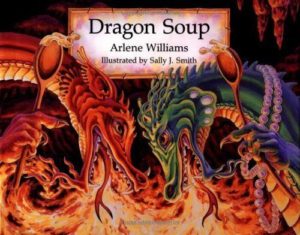
|
In Arlene Williams’s Dragon Soup (H.J. Kramer, 1996), young Tonlu, trying to save her poverty-stricken family, sets out to steal some of the Cloud Dragons’ horde of pearls. She’s caught in the act, and ends up forced to judge a soup contest between rival dragon brothers. Luckily the astute Tonlu has a talent for conflict resolution. For ages 4-8. |
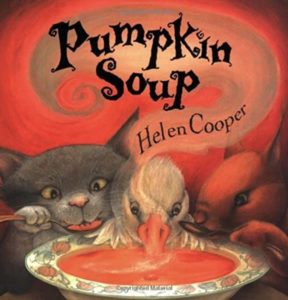
|
In Helen Cooper’s Pumpkin Soup (Square Fish, 2005), buddies Cat, Duck, and Squirrel live happily together in a little white (pumpkin-shaped) cabin in the woods, where they collaborate on music (Cat plays the bagpipes) and cooking pumpkin soup. One day a squabble breaks out over who adds what to the soup, and angry Duck packs up his wheelbarrow and leaves in a huff. Soon Cat and Squirrel miss him – and when he finally returns, all have learned a lesson about the value of friendship (and the importance of taking turns). Included is a recipe for Pumpkin Soup. Further soup stories featuring Cat, Duck, and Squirrel are Delicious! (Farrar, Straus & Giroux, 2007) and A Pipkin of Pepper (2008). For ages 4-8. |
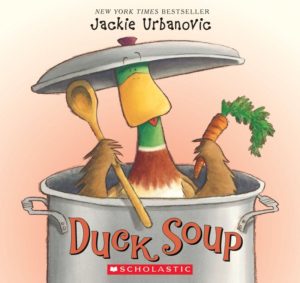
|
In Jackie Urbanovic’s Duck Soup (HarperCollins, 2008), Maxwell Duck – a master chef of soups, creator of Red HOT Chili Soup, Cracker Barrel Cheese and Marshmallow Soup, and Way Way Too Many Beans Soup – has embarked on a soup masterpiece. Just as he goes to the garden for a missing herb, however, three friends stop by. Spotting a floating feather in the simmering soup, they fear the worst and embark on an hysterical search. For ages 4-8. |
| From Kids’ Wings, Duck Soup has a lesson plan, literary connections, and extension activities to accompany the book. | |
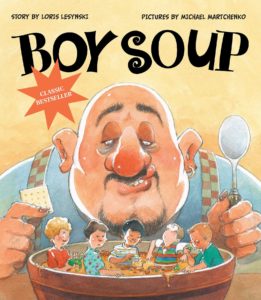
|
In Loris Lesynski’s rhyming Boy Soup (Annick Press, 2008), Giant, down with a cold, discovers that the ideal cure is a steaming bowl of Boy Soup. He snatches a batch of boys to boil – plus one girl, quick-thinking Kate, who manages to convince the miserable giant that Boy Soup is made by boys, not of boys. By the end, Kate and friends have opened a soup restaurant, and the giant has sworn off boys. For ages 4-9. |
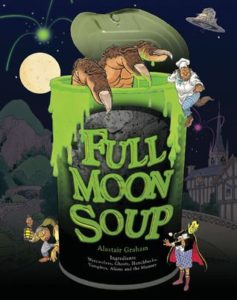
|
In Alastair Graham’s marvelously detailed wordless picture book Full Moon Soup (Boxer Books, 2009), there’s a full moon over the Hotel Splendide and there’s chartreuse soup for supper. Suddenly mayhem ensues: the soup-sipping chef becomes a werewolf; a bedspread attacks a maid; ghosts appear in the attic; space aliens, Vikings, and sheep attack. A mix of Where’s Waldo? and Monty Python for ages 5 and up. |
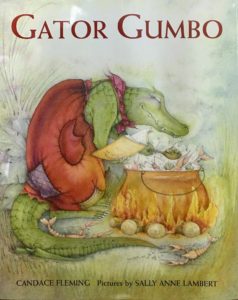
|
In Candace Fleming’s Cajun-style Gator Gumbo (Farrar, Straus & Giroux, 2004), Old Monsieur Gator is too old and slow to catch possums, skunks, and otters anymore – and all the animals tease him, taunt him, and drop eggs on his head. Finally he decides to cook up a pot of gumbo like Maman used to make – but when he asks for help, all the animals refuse. When the gumbo is done, however, they’re all eager to have a taste – but when they lean over to take a sip, over they go into the pot. They’ve all been so mean that you find you don’t really mind. For ages 4-8. |
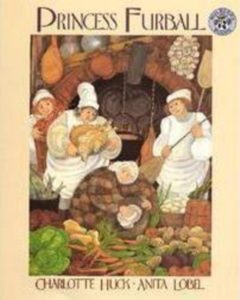
|
Charlotte Huck’s Princess Furball (Greenwillow Books, 1994) is a Cinderella tale, with soup. The motherless princess, whose greedy father plans to marry her off to a wealthy ogre, escapes, disguised in her coat (made from the fur of a thousand animals), and taking with her three dresses, three golden tokens belonging to her mother, and a packet of special soup seasoning. Hired to work in the palace kitchen of a neighboring kingdom, Furball manages to attend three balls, each time dropping a golden token in the prince’s soup. The prince discovers that the mysterious token-dropping guest is Furball, declares his love, and the two live happily ever after. For ages 4-8. |
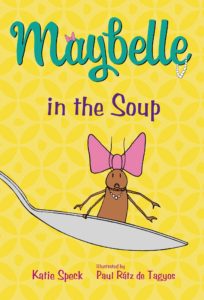
|
Katie Speck’s comical short chapter book Maybelle in the Soup (Henry Holt and Co., 2007) features Maybelle, a charming cockroach – she wears pearls and a pink bow – who lives, discretely, under the refrigerator in the home of Myrtle and Henry Peabody. Disaster strikes when the snooty Mr. and Mrs. Snodgrass come to dinner – and Maybelle, who simply can’t resist a taste, falls into the turtle soup. Sequels are Maybelle Goes to Tea (2008) and Maybelle and the Haunted Cupcake (2012). For ages 6-10. |
| From Kids’ Wings, Maybelle in the Soup has research links, literary connections, and an activity guide to accompany the book. | |
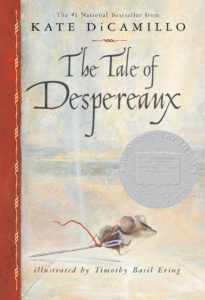
|
By Kate DiCamillo, The Tale of Despereaux: Being the Story of a Mouse, a Princess, Some Soup and a Spool of Thread (Candlewick, 2006) features – along with the title character, a little mouse with too-big ears – the beautiful Princess Pea, whom Despereaux adores; Roscuro, a soup-loving rat, and Miggery Sow, a dimwitted orphan girl, who dreams of taking the place of the princess. Soup plays an essential part in the story, especially when Roscuro, dangling from the palace chandelier, falls into the queen’s bowl of soup, which causes the queen to die. A wonderful read for ages 7 and up. |
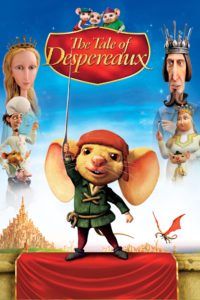
|
In the computer-animated movie version of The Tale of Despereaux (2008), Despereaux is voiced by Matthew Broderick, Roscuro by Dustin Hoffman, Princess Pea by Emma Watson, and Miggery Sow by Tracy Ullman. Rated G. |
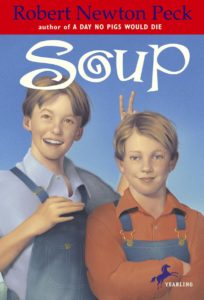
|
Robert Newton Peck’s Soup (Yearling, 1998) is an autobiographical account of Peck’s childhood experiences in rural Vermont in the 1920s – along with his best friend Soup, a genius at getting the two of them into trouble. (Soup’s real name is Luther, to which he refuses to answer. But he always responds when his mother yells “Soup’s on!”) There are several sequels. For ages 8-11. |
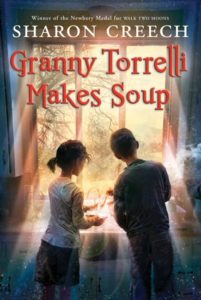
|
In Sharon Creech’s Granny Torrelli Makes Soup (HarperCollins, 2005), twelve-year-old Rosie and her best friend, Bailey (“that Bailey boy”) – who is legally blind – have had a rift, and just because Rosie has learned to read Braille. Through cooking, stories, and good advice, Granny Torrelli teaches the two some lessons about lasting friendship. For ages 9-13. |
